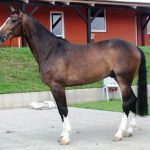Westphalian Horse
The Westphalian is a breed of sturdy and active horses that developed in Germany. They are known for their versatile skills, both as a working as well as a sports horse that has reached to the Olympic levels.
Westphalian Horse Pictures
- Images of Westphalian
- Westfalen Horse
- Westphalian Horse Foal
- Westphalian Horse Jumping
- Westphalian Horse
- Westphalian Horses
- Westphalian Images
- Westphalian Mare
- Westphalian Photos
- Westphalian Pictures
- Westphalian Stallion
- Westphalian
Quick Information
| Other Names | Westfalen, Westfälisches Pferd |
| Behavioral Characteristics | Calm, friendly, willing, adaptable, versatile |
| Physical Traits | Lightly built but tall stature with a well-shaped back and chest and strong, well-muscled hindquarters; the neck is stout, coming out in good angles from the shoulders and withers |
| Coat Colors | Black, bay, chestnut, and gray are common |
| Height/Size | 17.2 hands (adult) |
| Weight | 1,150 pounds |
| Common Uses | Jumping, dressage, eventing, racing |
| Health Problems | No breed-specific health issues |
| Type | Riding Horse, Sports Horse, Show Horse, Working Horse |
| Blood Type | Warm |
| Popular Traits | Multi-talented, excellent in jumping, easy trainability |
| Feeding/Diet | General horse diet including hay, grass, grains, etc. |
| Time of Origin | 1826 |
| Country of Origin | Westphalia, Germany |
| Associations and Registries | Westfalen Horse Association of America Breed Standards (German) |
Video: Westphalian Horse Sporting Event
History and Development
During the early 19th century, agriculture had been the primary profession of the rustics and the countryside populations in Germany, while their work and transport mainly depended on working horses. With the gradual rise in population and the resultant growth of the agriculture industry, a need for a versatile and healthy working animal grew rapidly.
In 1826, the State Stud of Warendorf (SSW) was founded in the town of Warendorf in North Rhine-Westphalia in Germany intending to improving the local equine breeds. It was the initiative of this stud that the Westphalian breed was created by selective breeding choosing the best horses, including Oldenburg, Hanoverian, and Anglo-Norman from different regions, keeping in mind the needs of the ordinary people.
The Westphalians continued to remain the choice of the farmers for agriculture and other related works, as the horse that could plow fields, carry people, pull carts to town until the tractor came to the scene for the first time. At present, these animals are mainly bred for their versatile traits, starting from pulling carriages to sports like jumping, dressage, or eventing.
Interesting Facts
- The Westphalian has the second largest breeding population in Germany (next only to the Hanoverian Horse).















